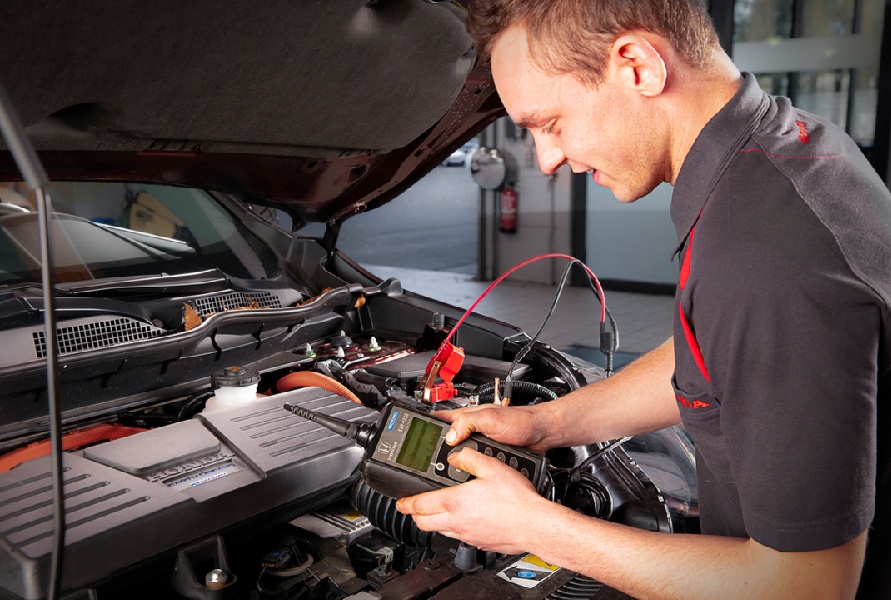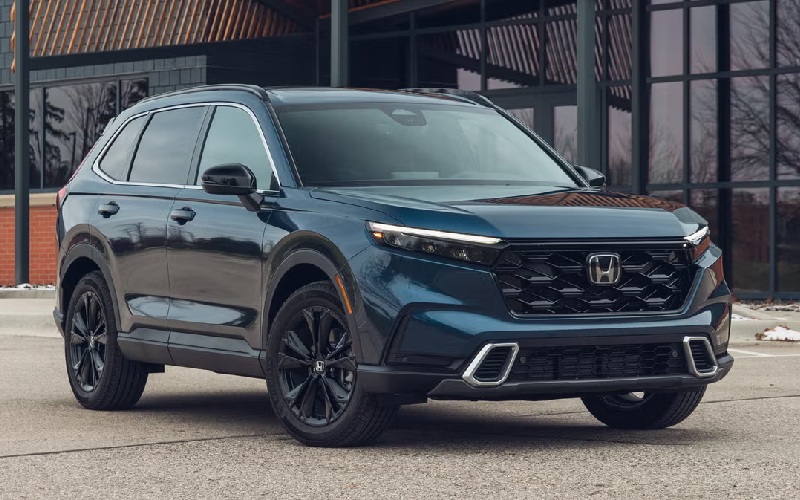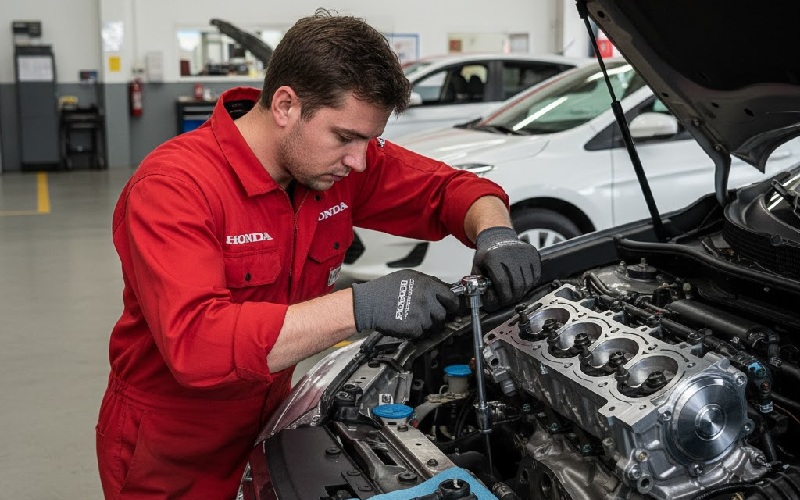As the automotive world rapidly evolves toward electrification, prospective vehicle owners face important decisions about which powertrain technology best suits their needs. Honda, with its diverse lineup spanning traditional internal combustion engines, hybrids, and all-electric vehicles, offers multiple options for today’s consumers. Understanding the maintenance differences between these technologies can significantly impact ownership experience and long-term satisfaction.

The Fundamental Differences
At their core, electric vehicles (EVs) and internal combustion engine (ICE) vehicles operate on fundamentally different principles, resulting in distinctly different maintenance requirements.
Mechanical Complexity
The most significant advantage of electric vehicles lies in their mechanical simplicity:
- Engine vs. Motor: A typical Honda gasoline engine contains 200+ moving parts requiring precise tolerances and lubrication. These components experience friction, heat cycles, and combustion forces that inevitably lead to wear. In contrast, a Honda electric motor typically has just one moving part – the rotor – resulting in dramatically reduced mechanical wear.
- Transmission Differences: Conventional Honda vehicles utilize complex multi-speed transmissions with numerous gears, clutches, bands, and hydraulic systems. Most EVs, including Honda models, use a simple single-speed reduction gear that requires minimal maintenance over the vehicle’s life.
- Auxiliary Systems: Traditional vehicles require numerous supporting systems for the engine, fuel delivery, exhaust, emissions controls, and extensive cooling systems. EVs eliminate most of these components, though they require sophisticated battery thermal management systems.
Fluid Requirements
The difference in fluid maintenance represents one of the most tangible service contrasts:
- Engine Oil: Conventional Honda vehicles require oil changes typically every 8,000-12,000 kilometers, depending on driving conditions. This ongoing maintenance is not necessary in full electric vehicles.
- Transmission Fluid: Traditional automatics and CVTs in Honda’s gasoline lineup require periodic fluid changes, typically every 48,000-80,000 kilometers. EVs have dramatically simplified transmission systems with fluid that rarely, if ever, needs replacement.
- Coolant Systems: While both vehicle types use coolant, the systems serve different purposes. In EVs, coolant primarily manages battery and electronics temperatures rather than extreme combustion heat. Honda EV coolant systems typically require less frequent service, often with intervals of 160,000 kilometers or more.
- Brake Fluid: Both vehicle types require periodic brake fluid changes, typically every 3 years, regardless of kilometers driven, making this one item that remains consistent across platforms.
Braking Systems
The braking approach differs significantly between vehicle types:
- Regenerative Braking: EVs like the Honda Prologue recover energy during deceleration, using the electric motor as a generator to recharge the battery. This process significantly reduces wear on friction braking components.
- Mechanical Brake Use: In traditional vehicles, friction brakes handle all deceleration, leading to more frequent pad and rotor replacements. Honda EV owners typically experience 2-3 times longer brake component life due to reduced reliance on friction brakes.
- Brake Maintenance Needs: EVs require less frequent brake pad replacement. However, they benefit from periodic brake service to prevent calliper binding or corrosion from lack of use – an interesting service reversal from conventional vehicles.
Component-by-Component Maintenance Comparison
Powertrain Maintenance
The heart of any vehicle is its powertrain, and the differences here are substantial:
Honda Gasoline Vehicles Require:
- Engine oil and filter changes (8,000-12,000 km)
- Spark plug replacement (96,000-160,000 km)
- Air filter replacement (24,000-48,000 km)
- Fuel filter service (80,000-160,000 km)
- Timing belt replacement (on some engines, 160,000 km)
- Valve adjustments (certain engines, 48,000-96,000 km)
- Engine coolant replacement (80,000-160,000 km)
- Transmission service (48,000-80,000 km)
Honda Electric Vehicles Require:
- Battery coolant check (minimal service intervals)
- Drive unit fluid inspection (rarely needs replacement)
- High-voltage battery health checks (during regular service)
- Software updates (as available)
The powertrain maintenance difference represents thousands of kilometers where EV owners simply drive without service requirements.
Brake System Maintenance
Braking system differences lead to varied service needs:
Honda Gasoline Vehicles:
- Brake pad replacement typically every 48,000-64,000 km
- Brake rotor machining or replacement with pad service
- Brake fluid replacement every 3 years
- Periodic calliper service and lubrication
Honda Electric Vehicles:
- Brake pad replacement typically every 96,000-128,000 km
- Less frequent rotor service due to reduced wear
- Brake fluid replacement every 3 years (unchanged)
- More frequent calliper inspection due to reduced use
The regenerative braking advantage significantly reduces brake service frequency for most Honda EV owners.
Emissions Systems
Perhaps the most dramatic maintenance contrast lies in emissions systems:
Honda Gasoline Vehicles Require:
- Oxygen sensor replacements (96,000-160,000 km)
- Catalytic converter efficiency monitoring
- Evaporative emissions system testing
- EGR system on some models
- Potential carbon buildup cleaning in direct injection engines
- Periodic emissions testing in many regions
Honda Electric Vehicles:
- No emissions systems to maintain
- No emissions testing required
- Zero emissions components to fail or replace
This category represents a pure elimination of maintenance for EV owners, with no equivalent systems requiring attention.
Routine Schedule Comparison
To understand the practical impact of these differences, comparing typical maintenance schedules illuminates the contrast in ownership experience:
First 24,000 Kilometers
Honda Civic (Gasoline):
- 8,000 km: Oil and filter change, inspection
- 16,000 km: Oil and filter change, tire rotation, inspection
- 24,000 km: Oil and filter change, cabin filter, brake service
Honda Prologue (Electric):
- 12,000 km: Tire rotation, inspection
- 24,000 km: Cabin filter, brake inspection, tire rotation
The EV advantage is immediately apparent with significantly fewer service visits and service items.
Years 3-5 (48,000-80,000 km)
Honda Civic (Gasoline):
- Continued oil changes every 8,000 km
- Transmission fluid service
- Air filter replacements
- Spark plug inspection/replacement (turbocharged models)
- Multiple brake inspections and potential service
- Engine coolant service
Honda Prologue (Electric):
- Annual inspections
- Cabin filter replacements
- Potential brake service (though often not yet needed)
- Tire rotations and replacements at similar intervals to gasoline models
The divergence grows over time, with conventional vehicles accumulating more service requirements while EVs maintain their simplified schedule.
Long-Term Ownership (160,000+ km)
At higher mileage, the contrast becomes even more significant:
Honda Gasoline Vehicles:
- Major services include timing belts on some models
- Water pump replacement is often recommended with a timing service
- Transmission service becomes more critical
- Potential valve adjustments
- Multiple ignition system components approaching replacement intervals
- Increased risk of exhaust and emissions system repairs
Honda Electric Vehicles:
- Battery health becomes a monitoring point, though not necessarily a service item
- First brake service may occur if not done earlier
- Suspension components experience similar wear to conventional vehicles
- Climate control systems maintain similar service intervals to conventional vehicles
The long-term ownership experience reveals dramatically different service profiles, with EV owners experiencing fewer major service events.
Real-World Considerations
Beyond scheduled maintenance, several practical factors influence the overall experience:
Unscheduled Repairs
The simplicity of electric vehicles often translates to improved reliability:
- Potential Failure Points: With fewer mechanical components and systems, EVs simply have fewer things that can malfunction. Honda’s conventional vehicles contain approximately 2,000+ moving parts, while EVs reduce this by 75-90%.
- Battery Reliability: While concerns about battery failure exist, real-world data shows modern EV batteries demonstrate exceptional reliability, with failure rates significantly lower than many traditional powertrain components.
- Electrical System Comparison: While EVs rely heavily on electronics, modern gasoline vehicles also contain sophisticated electronics that require similar expertise when problems occur. The difference lies not in the presence of electronics but in the absence of additional mechanical systems in EVs.
Maintenance Accessibility
The approach differs between platforms:
- DIY Considerations: Traditional vehicles offer more DIY maintenance opportunities for owners comfortable with basic service. EVs consolidate more maintenance into specialized service centers due to high-voltage safety considerations.
- Specialized Service: Honda EV maintenance requires specific training and equipment, particularly for high-voltage systems. This specialization can influence service availability and processes.
- Diagnostic Approaches: EV issues are typically diagnosed through sophisticated computer systems rather than mechanical inspection, changing the troubleshooting approach.
Regional Factors
Location can influence experiences:
- Climate Impacts: Extreme cold regions may see different battery performance characteristics requiring more attention to thermal management, while hot regions place different demands on cooling systems.
- Driving Patterns: Urban drivers benefit most dramatically from EV maintenance advantages. Meanwhile, highway-focused drivers see reduced advantages due to less regenerative braking opportunity and already-optimal engine operation in conventional vehicles.
- Service Network: Access to qualified EV service can vary by region, potentially affecting the ownership experience during the transition period as infrastructure develops.
The Total Cost Perspective
When evaluating the comparison between Honda electric and gasoline vehicles, several factors contribute to the total cost perspective:
Scheduled Maintenance Savings
Industry studies consistently show that EV service costs run 40-60% lower than comparable internal combustion vehicles over a typical ownership period. For Honda vehicles, this translates to meaningful savings:
- Elimination of Engine Services: The absence of oil changes alone saves 15-20 service visits over a 160,000 km vehicle lifespan.
- Reduced Brake Service: The regenerative braking advantage typically reduces brake service frequency by 50-70%, often allowing Honda EV brake components to last 160,000+ kilometers.
- Simplified Inspections: While both platforms require regular inspections, EV inspections focus on fewer systems and typically require less adjustment or correction.
Long-Term Reliability Considerations
As vehicles age, the maintenance contrast often becomes more pronounced:
- Powertrain Longevity: Electric motors typically outlast internal combustion engines significantly, with many designed to operate for 400,000+ kilometers without major service.
- Wear-Related Repairs: The simplified mechanical nature of EVs reduces age-related maintenance as vehicles accumulate kilometers. Gasoline vehicles typically experience increasing maintenance needs as they age.
- Battery Considerations: While battery capacity may gradually decline, this represents a performance characteristic rather than a failure requiring repair. Modern Honda EV batteries retain 70-80% capacity after 8-10 years of use.
The Overall Ownership Equation
When evaluating total ownership costs:
- Initial Purchase Consideration: The purchase price premium for electric vehicles is increasingly offset by operational savings, including fuel and service.
- Resale Impact: Reduced mechanical wear potentially translates to better long-term value retention, though the market continues to evolve.
- Time Value: Beyond direct costs, the reduced time spent on maintenance – fewer service visits and shorter service durations – represents a meaningful ownership advantage.
The Transition Between Platforms
For those considering a switch between gasoline and electric Honda vehicles, understanding the key maintenance transitions helps set appropriate expectations:
Adjusting to Electric Ownership
New Honda EV owners should consider these adjustments:
- Service Interval Changes: Rather than the oil-change-driven service schedule, EVs follow extended intervals primarily dictated by tire rotation and general inspection needs.
- Different Service Focus: Service visits shift from fluid and filter-centric to software and system inspections, changing the service center experience.
- Home Charging Maintenance: Home charging infrastructure requires occasional inspection of cables, connections, and electrical systems.
Hybrid as Transition Technology
Honda’s hybrid offerings like the CR-V Hybrid, Accord Hybrid and Civic Hybrid present an interesting middle ground:
- Partial Advantages: Hybrids maintain some EV service advantages, including extended brake life and reduced engine operation, while retaining most traditional maintenance items.
- Complexity Consideration: Hybrids represent the most complex profile, combining conventional and electric components, requiring service.
- Transition Benefits: For those hesitant about full electric ownership, hybrids provide a gradual introduction to electric components while maintaining familiar service patterns.
As Honda continues expanding its electrified lineup, understanding these differences helps owners select the powertrain technology that best aligns with their priorities, driving patterns, and ownership preferences. Both platforms offer compelling advantages, with electric vehicles presenting significant simplification that many owners find increasingly attractive as the technology matures.
Questions and Answers
Do electric Honda electric vehicles save money on maintenance compared to gasoline models?
- Yes, they typically reduce costs by 40-60% compared to equivalent gasoline models over a typical ownership period. These savings come primarily from eliminating oil changes, reducing brake wear through regenerative braking, and avoiding service on complex systems like transmission, exhaust, and emissions components. The simplified powertrain in EVs requires fewer adjustments, replacements, and service intervals.
What maintenance items remain similar between Honda electric and gasoline vehicles?
- Several items remain consistent across both platforms. Tire rotations and replacements follow similar schedules based on wear. Cabin air filters require regular replacement in both vehicle types. Suspension and steering components experience similar wear patterns and inspection requirements. Brake fluid requires replacement at similar intervals (typically every 3 years) regardless of powertrain. Additionally, body and chassis service, including corrosion protection, follows similar schedules.
How does Honda hybrid maintenance compare to both conventional and all-electric models?
- These vehicles represent a middle ground in requirements. They retain conventional items like oil changes, though often at extended intervals due to reduced engine operation. They benefit from partial regenerative braking advantages, extending brake component life compared to conventional models. They also require service on both conventional and electric systems, potentially making them the most intensive option in some respects. However, these systems have proven exceptionally reliable, partially offsetting the complexity factor.
What are the most significant maintenance differences owners notice when switching from a gasoline Honda to an electric model?
- The most immediately noticeable difference is the elimination of oil changes, dramatically reducing service visit frequency. Owners also observe significantly extended brake component life due to regenerative braking. Service visits for electric models focus more on software updates and system checks rather than fluid and filter replacements. Additionally, many EV owners appreciate reduced noise and vibrations that often develop in aging gasoline vehicles, as electric drivetrains tend to maintain their smooth, quiet operation characteristics over time.
Do electric vehicles require any unique maintenance that gasoline vehicles don’t need?
- While EVs eliminate many traditional items, they introduce some unique considerations. Battery health checks become an important diagnostic element during service visits. High-voltage electrical system inspections require specialized equipment and training. Cooling systems for batteries and electronics need periodic evaluation. Some EVs benefit from occasional brake system service to prevent corrosion from lack of use, as regenerative braking reduces use of traditional friction brakes. Additionally, home charging equipment requires periodic inspection to ensure safe, efficient operation.




